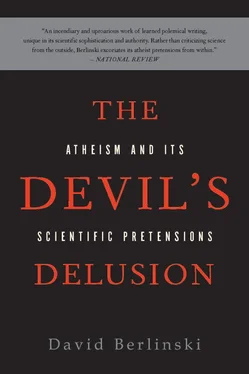In this, the physicists were immeasurably assisted by the philosophers, their traditional enemies, of course, who aided in the work at hand by writing very elegant papers demonstrating that if the universe had a beginning, it was not a beginning that really began. The philosopher Adolf Grünbaum of the University of Pittsburgh was a master of this approach. If the universe did not have a beginning, his papers did not have an end. Fair is fair. Physicists who had been struggling to make precisely the same point welcomed such philosophical efforts with the relief a stutterer might show on having his interlocutor blurt out the stammered word.
All might have been well, or at least better than it turned out to be, had the Big Bang been another one of those tedious ideas that flicker luridly for a moment and then wink out. There are so many of them. But quite the contrary proved to be the case. Over the course of more than half a century—a very long time in the history of the physical sciences—inferences gathered strength separately, and when combined they gathered strength in virtue of their combination.
One line of inference was observational; the second, theoretical; the two together, irresistible.

The observations that made the hypothesis of the Big Bang plausible were derived from a study of the heavens. They had some of the brute power of something seen. This is an exaggeration, of course. Observations themselves depend on a network of theoretical assumptions, but in the case of these observations, their theoretical structure belonged to a part of physics that was well understood. No astronomer scanning the cosmos, for example, doubted much the plainest of plain facts about light. No matter how it appears, light represents an undulation of the electromagnetic field. Its source is the excitable atom itself, with electrons bouncing from one orbit to another and releasing energy as a result. If this is so, it follows that each atom has a spectral signature, a distinctive electromagnetic frequency. The light that streams in from space thus must reveal something about the composition of the galaxies from which it was sent. In the early years of the twentieth century, the characteristic signature of hydrogen was detected in various far-off galaxies. Examining a very small sample of twenty or so galaxies, the American astronomer Vesto Slipher observed that the frequency of their hydrogen atoms was shifted to the red portion of the spectrum. Using a far more sophisticated telescope than any at Slipher’s disposal, Edwin Hubble made the same discovery in the early 1930s, and unlike poor Slipher, he knew he had struck gold.
The galactic redshift, Hubble realized, was an exceptionally vivid cosmic clue, a bit of evidence from far away and long ago, and as with all clues its value lay in the questions it prompted. Why should galactic light be shifted to the red and not the blue portions of the spectrum? Why, for that matter, should it be shifted at all?
These very simple questions received an equally simple answer, with neither question nor answer ever transgressing the margins of plain physical sense. The pitch of a siren is altered as a police car disappears down the street, the sound waves carrying the noise stretched by the speed of the car itself. This is the familiar Doppler effect. Something similar explains the redshift of the galaxies. Distortions in their spectral signature arise because these monsters of the night are receding into the depths. But a universe whose galaxies are receding is one that is expanding.
The inference to the Big Bang now follows. A universe that is expanding is a universe with a clear path into the past. If things are now far apart, they must at one point have been close together; and if things were once close together, they must at one point have been hotter than they are now, the contraction of space acting to compress its constituents like a vise, and so increase their energy. The retreat into the past ends in a state in which material particles are at no distance from one another and the temperature, density, and curvature of the universe are infinite. Such a state is known as a singularity, and in the case of the cosmos it is known as the Big Bang singularity.
The cone tapering into the past must end. The lines of sight converge. The universe had a beginning.
When the facts about an expanding universe became known, physicists at once realized that they had become known in the right place and at the right time. In 1915, Albert Einstein had published his theory of general relativity. The theory represented the culmination of a revolution in physical thought that he had initiated in 1905 with the publication of his theory of special relativity. The greater, grander theory encompassed Einstein’s account of gravitation, but because gravitation extends throughout space and time as a universal force, his theory was simultaneously a kind of cosmic blueprint, a way of grasping by mathematical means the ultimate structure of the cosmos.
General relativity forges a far-flung connection between the geometry of space and time and the presence of matter. Events within Einstein’s majestic theory are designated by four numbers. Three of these numbers indicate where the event is, and the fourth measures when it is there. Physicists very much enjoy suggesting that the world of four dimensions is so inaccessible that entrance is generally denied the mathematically uninitiated. But although those four dimensions are important, the underlying concept is simple. After all, we locate an event in terms of both where it took place and when it took place. Where was JFK assassinated? Three numbers provide the answer (longitude, latitude, and height). And when? One number is sufficient. To have grasped this much is to have grasped everything. (And as long as secrets are being imparted, when physicists talk of ten-dimensional or eleven-dimensional spaces, nothing deeper is at issue.) To a fused form of space and time in which points are identified by four numbers, Einstein assigned a variable geometrical structure. Squeezing a solid rubber ball produces the same effect, although not, of course, on the same scale. Now it is perfectly round. A squeeze is administered, and then it becomes deformed. With the release that follows, its shape changes again, and with its shape, its geometry.
If the geometry of space and time is variable, Einstein conjectured, this must affect the way in which material objects move through the medium of space and time. A beam of light crossing an otherwise empty universe travels in a straight line. Place a massive star in its path, and the light beam will curve, almost as if its graceful swerve were intended to avoid a collision. By the same token, an observer falling toward the earth, his failed parachute dangling uselessly behind him and an ignominious plop forthcoming, is doing nothing more than traveling along his natural path through space and time. He appears to be accelerating because the earth has distorted the geometry through which he is falling.
Einstein’s theory of general relativity involves the cohabitation of these conceptual partners. Material objects influence space and time by deforming their geometry. Space and time influence material objects by changing their path. The relationship goes both ways.
The field equation that Einstein introduced in 1915 is a majestic identity in which curvature, on the one side, and mass, on the other, are placed in the balance and found equal. Einstein had hoped that the equations of general relativity would determine a single world model, and like virtually every other physicist, he believed that his cosmic blueprint would reveal a universe that had neither a beginning nor an end. Searching for what he wished to find, Einstein discovered a solution to his own equations that specified just such a universe, the great thing having been there from the infinite past and destined to be there into the infinite future. For reasons that he could never make clear, Einstein found a universe so conceived particularly satisfying. Friends of his who knew him well have suggested (to me) that to the end of his life, Einstein regarded an expanding universe with a certain fastidious distaste.
Читать дальше













